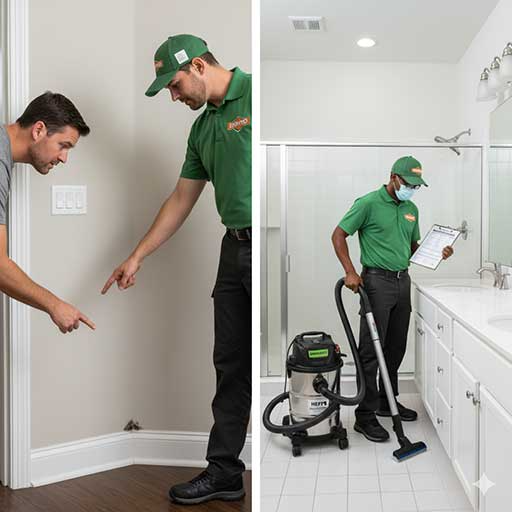
Scope & limits (disclaimer)
This content provides informational insight into professional deep-cleaning practices. It does not include proximity phrasing, calls-to-action, phone prompts, ZIP finders, or links. It does not constitute medical advice, and it contains no product recommendations or claims of efficacy against specific pathogens. Brand names, where mentioned, are purely descriptive; no affiliation, endorsement, or warranty is implied. The purpose is to describe operational procedures and standard practices commonly observed in professional cleaning services.
What a deep-clean visit typically covers
Deep-clean visits are generally structured around a written scope and a detailed room-by-room checklist to ensure consistency and thoroughness.
Kitchen: Professionals usually focus on degreasing hobs, extractor hoods, and backsplashes. Exterior surfaces of appliances are cleaned, and interior cleaning is done if pre-agreed with the client. High-touch points such as handles, knobs, and switches receive special attention. Some providers include additional areas such as pantry shelves or small countertop appliances depending on the agreed scope.
Bathrooms: Cleaning in bathrooms often involves the removal of general soil, reducing mineral build-up, and non-remediation mildew cleaning. Ventilation grilles, fixtures, switches, and other commonly touched surfaces are included. Crews take care to use methods and materials that do not damage tiles, glass, or metal fittings while ensuring visible cleanliness.
Floors & textiles: Floor care often includes HEPA-rated vacuuming, which captures fine dust and particulates effectively. When included in the scope, low-moisture extraction is applied to upholstery, carpets, and rugs. Providers may adjust techniques according to material sensitivity, such as stone, wood, or synthetic fabrics.
High-touch disinfection: Door handles, rails, switches, desk edges, and similar surfaces are treated following proper product-label contact times. This helps maintain a consistent level of hygiene for areas frequently handled by household members or visitors.
Exact tasks vary depending on the agreed-upon written scope and the type of property being serviced.
Disinfection protocols (methods, not marketing)
A common sequence for disinfection includes pre-cleaning surfaces, applying an appropriate disinfectant, respecting the labeled contact time, and avoiding cross-contamination. This often involves the use of color-coded cloths or separate tools for bathrooms and kitchens. Providers select products suitable for each surface, following manufacturer instructions, but this content makes no claims regarding pathogen-specific efficacy and does not provide product recommendations. Clients should confirm product choices and usage details directly with the service provider.
Family-aware adjustments (non-medical)
In households with older adults, children, or pets, cleaning crews often adapt their techniques to reduce disruption or risk. These adaptations may include long-reach dusters for hard-to-access areas, low-splash applications, slip-aware floor care, low-odor or fragrance-free solutions on request, and added focus on high-touch areas such as banisters, appliance handles, and taps. These measures are operational and do not constitute medical or remediation services.
Planning & expectations (neutral)
Rather than promising proximity or specific timelines, it is recommended to align on a written scope, an availability window, and any sensitivities such as fragrance-free preferences or ventilation needs. Clients and providers should confirm in advance if the cleaning of appliance interiors (e.g., oven, fridge) or soft surfaces (e.g., upholstery, rugs) is included. Expectations should focus on procedure and coverage, not guaranteed outcomes.
Quality you can review
Transparency is often increased through several methods:
-
Conducting a brief walk-through to set priorities and identify delicate surfaces.
-
Using a visible task checklist during the service to track progress.
-
Providing an end-of-visit summary noting completed items and offering care guidance, such as recommended dry times for floors or textiles.
Policies and practices vary; clients should confirm the details in writing with their provider.
Materials & surface care (examples)
“Thorough” cleaning does not mean harsh treatment. Common practices include using pH-appropriate chemistry for stone surfaces, non-etch formulas on glass, peroxide blends in bathrooms where suitable, and neutralizers after strong degreasers. HEPA capture combined with damp wiping helps limit re-aerosolization of fine dust. Fragrance-free options may be provided for sensitive occupants, and delicate surfaces should be disclosed during the walk-through so they can be protected or skipped as needed.
Illustrative scenarios (not guarantees)
-
Move-in / Move-out: Deep cleaning of kitchen and bathroom, interior of appliances if scoped, baseboards, and textiles refreshed where included.
-
Post-construction dust: Multi-pass HEPA vacuuming combined with damp wiping of horizontal surfaces and vents to remove fine particulate.
-
After a household illness: High-touch cleaning and disinfection following labeled contact times; soft-surface refresh included if scoped.
-
Pet or smoke odor: Targeted textile cleaning and odor-control steps using controlled moisture and extraction techniques.
Results vary depending on materials, soil level, and the scope agreed upon.
What to expect on the day (descriptive flow)
The visit typically starts with an access check and walk-through to align priorities and identify delicate surfaces. Protection measures, such as corner guards or floor runners, may be applied where appropriate. Execution proceeds according to the written scope: degreasing, HEPA vacuuming, low-moisture extraction if specified, and disinfection following product contact times. The visit concludes with a checklist review and any care guidance, such as recommended drying periods. Exact steps vary by provider and scope.